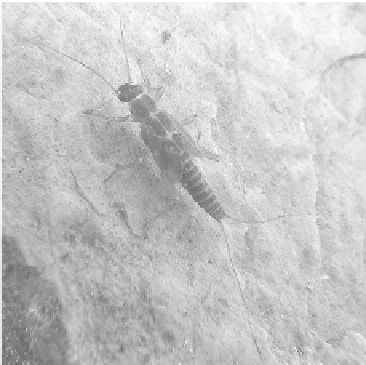Geoscience Reference
In-Depth Information
Figure 20.4.
Lednia tumana—a macro invertebrate species endemic to the Waterton-Glacier
International Peace Park (WGIPP) area (Canada and USA) and a recent candidate for listing
under the U.S. Endangered Species Act due to climate-change-induced glacier loss (Credit:
Joe Giersch, USGS).
species endemic to the Waterton-Glacier International Peace Park (WGIPP)
area (Canada and USA) and a recent candidate for listing under the U.S.
Endangered Species Act due to climate-change-induced glacier loss. During
14 years of research,
L. tumana
was found to inhabit a narrow distribution,
restricted to short sections (~500 m) of cold, alpine streams directly below
glaciers, permanent snowfi elds and springs. Bioclimatic models suggest that
climate change threatens the potential future distribution of these sensitive
habitats and the persistence of
L. tumana
, with the species predicted to lose
over 80% (current ~23 km
2
, future ~4.5 km
2
) of its potential current range
under future warming induced glacier and perennial snowfi eld loss. These
projected reductions in suitable habitat suggest that
L. tumana
may be one of
the fi rst known macro invertebrates to become extinct due to recent climate
change. Mountain top aquatic invertebrates that exhibit severe climate-
related range-restrictions are ideal early-warning indicators of thermal and
hydrological modifi cation that may be associated with climate warming in
mountain ecosystems.
Bull trout
The bull trout (
Salvelinus confluentus—
Fig. 20.6) is a native char to
northwestern North America, including portions of the Rocky Mountains in
Canada and the United States, which requires large, ecologically diverse and
connected coldwater river and lake habitats for persistence (Fig. 20.5). Bull
trout populations have declined throughout much of their native range, and


Search WWH ::

Custom Search